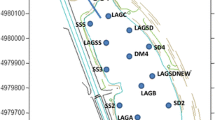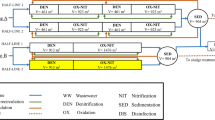Abstract
The experimental assessment of the actual reactor hydrodynamic behavior is aimed at detecting possible deviations from the design configuration, as well as suggesting corrective/improving modifications, efficacy of which can be also assessed in the aftermath. The hydrodynamic scheme can be defined by means of tracer tests (stimulus–response method) used for detecting the residence time distribution curve. This study shows the results of three hydrodynamic tests performed on a wastewater treatment plant half-line, in which a biological process (denitrification and oxidation–nitrification) is carried out. Hydrodynamic faults (in terms of dead space and/or flow bypass) were identified, and consequent actions suggested (i.e., change in submerged mixers orientation in the reactors; sinking of the final section of the sludge recirculation pipe below the free surface to avoid foaming phenomena; introduction of new mixed liquor recirculation lines). These actions, together with a careful selection of wastes to be treated, led to an improvement of the overall process performance.










Similar content being viewed by others
References
Abou Hweij K, Azizi F (2015) Hydrodynamics and residence time distribution of liquid flow in tubular reactors equipped with screen-type static mixers. Chem Eng J 279:948–963
Alvarado A, Vedantam S, Goethals P, Nopens I (2012) A compartmental model to describe hydraulics in a full-scale waste stabilization pond. Water Res 46:521–530
Baléo JN, Le Cloirec P (2000) Validating a prediction method of mean residence time spatial distributions. AIChE J 46(4):675–683
Bertanza G, Collivignarelli C (2012) Impianti di trattamento acque: verifiche di funzionalità e collaudo. Manuale operativo. [Wastewater treatment plants: performing tests. Operative manual]. Editore Ulrico Hoepli Milano (in Italian)
Bridgeman J, Jefferson B, Parsons SA (2009) Computational fluid dynamics modelling of flocculation in water treatment: a review. Eng Appl Comput Fluid Mech 3(2):220–241
Brouckaert CJ, Buckley CA (1999) The use of computational fluid dynamics for improving the design and operation of water and wastewater treatment plants. Water Sci Technol 40(4–5):81–89
Collivignarelli C, Bertanza G, Bina S (1995) La verifica idrodinamica nel trattamento delle Acque-Basi teoriche, procedure di applicazione, esempi. [The hydrodynamic test in the water treatment—theoretical bases, application procedures, examples]. Collana Ambiente, volume 8. CIPA Ed., Milano (in Italian)
Collivignarelli MC, Abbà A, Alloisio G, Gozio E, Benigna I (2017a) Disinfection in wastewater treatment plants: evaluation of effectiveness and acute toxicity effects. Sustainability 9:1704
Collivignarelli MC, Abbà A, Benigna I, Sorlini S, Torretta V (2017b) Overview of the main disinfection processes for wastewater and drinking water treatment plants. Sustainability 10(1):86
Collivignarelli MC, Bertanza G, Abbà A, Damiani S (2018) Process auditing and performance improvement in a mixed wastewater-aqueous waste treatment plant. Water Sci Technol. https://doi.org/10.2166/wst.2017.605
Cruz-Díaz MR, Rivero EP, Almazán-Ruiz FJ, Torres-Mendoza À, González I (2014) Design of a new FM01-LC reactor in parallel plate configuration using numerical simulation and experimental validation with residence time distribution (RTD). Chem Eng Process 85:145–154
Dedewanou M, Binet S, Rouet JL, Coquet Y, Bruand A, Noel H (2015) Groundwater vulnerability and risk mapping based on residence time distributions: spatial analysis for the estimation of lumped parameters. Water Resour Manag. https://doi.org/10.1007/s11269-015-1130-8
Ding H, Xiang W, Song N, Liu C, Yuan X (2014) Hydrodynamic behavior and residence time distribution of industrial-scale bale packings. Chem Eng Technol 37:1127–1136
Italian Parliament (2006) Decreto Legislativo 3 aprile 2006, n. 152—Norme in materia ambientale [Legislative Decree 3rd April 2006, n. 152—code on the environment]. Official Gazette of the Italian Republic (in Italian)
Jafarikojour M, Sohrabi M, Royaee SJ, Rezaei M (2016) A new model for residence time distribution of impinging streams reactors using descending-sized stirred tanks in series. Chem Eng Res Des 109:86–96
Karpinska AM, Bridgeman J (2016) CFD-aided modelling of activated sludge systems—a critical review. Water Res 88:861–879
Lali F (2017) A hydrodynamic study of cylindrical metal foam packings: residence time distribution and two phase pressure drop. Chem Eng Process 115:1–10
Le Moullec Y, Gentric C, Potier O, Leclerc JP (2010) CFD simulation of the hydrodynamics and reactions in an activated sludge channel reactor of wastewater treatment. Chem Eng Sci 65(1):492–498
Levenspiel O (1999) Chemical reaction engineering, 3rd edn. Wiley, New York
Manenti S, Todeschini S, Collivignarelli MC, Abbà A (2017a) CFD-aided modelling for hydrodynamic analysis of biological reactor. Eur Water 58:47–51
Manenti S, Todeschini S, Collivignarelli MC, Abbà A (2017b) Integrated RTD-CFD hydrodynamic analysis for performance assessment of activated sludge reactors. Environ Process. https://doi.org/10.1007//s40710-018-0288-5
Musner T, Bottacin-Busolin A, Zaramella M, Marion A (2014) A contaminant transport model for wetlands accounting for distinct residence time bimodality. J Hydrol 515:237–246
Nauman EB (2008) Residence time theory. Ind Eng Chem Res 47:3752–3766
Pant HJ, Sharma VK, Shenoy KT, Sreenivas T (2015) Measurements of liquid phase residence time distributions in a pilot-scale continuous leaching reactor using radiotracer technique. Appl Radiat Isot 97:40–46
Rushd S, Islam A, Sanders RS (2018) CFD methodology to determine the hydrodynamic roughness of a surface with application to viscous oil coatings. J Hydraul Eng 144(2):04017067
Sorlini S, Collivignarelli MC, Canato M (2015a) Effectiveness in chlorite removal by two activated carbons under different working conditions: a laboratory study. J Water Supply Res Technol AQUA 64:450–461
Sorlini S, Collivignarelli MC, Castagnola F, Crotti BM, Raboni M (2015b) Methodological approach for the optimization of drinking water treatment plants’ operation: a case study. Water Sci Technol 71(4):597–604
Sorlini S, Biasibetti M, Gialdini F, Collivignarelli MC (2016) How can drinking water treatments influence chlorine dioxide consumption and by-product formation in final disinfection? Water Sci Technol Water Supply 16(2):333–346
Todeschini S, Papiri S, Ciaponi C (2012) Performance of stormwater detention tanks for urban drainage systems in northern Italy. J Environ Manag 101:33–45. https://doi.org/10.1016/j.jenvman.2012.02.003
Todeschini S, Papiri S, Ciaponi C (2014) Stormwater quality control for sustainable urban drainage systems. Int J Sustain Dev Plan 9:196–210. https://doi.org/10.2495/SDP-V9-N2-196-210
Tran TT, Kim D (2018) A CFD study of coupled aerodynamic-hydrodynamic loads on a semisubmersible floating offshore wind turbine. Wind Energy 21:70–85
Acknowledgements
Authors wish to thank ASMia S.r.l. for giving technical and financial support to the experimental research.
Author information
Authors and Affiliations
Corresponding author
Ethics declarations
Conflict of interest
All authors declare that they have no conflict of interest.
Additional information
Editorial responsibility: U.W. Tang.
Rights and permissions
About this article
Cite this article
Collivignarelli, M.C., Bertanza, G., Abbà, A. et al. Troubleshooting in a full-scale wastewater treatment plant: what can be learnt from tracer tests. Int. J. Environ. Sci. Technol. 16, 3455–3466 (2019). https://doi.org/10.1007/s13762-018-2032-0
Received:
Revised:
Accepted:
Published:
Issue Date:
DOI: https://doi.org/10.1007/s13762-018-2032-0




